Abstract
Global climate change is becoming increasingly prominent and has already begun to influence natural biological systems. Assessing the potential impact of climate change on ecosystems is an important research topic of the International Geosphere-Biosphere Programme (IGBP). Based on current distribution data, climate data, climate change scenarios (RCP8.5 scenario, 2070–2099), and application of the MaxEnt model, this study assessed suitability and sensitivity of the potential distribution of Cyclobalanopsis glauca forests under climate change conditions in Guizhou Province. The results were as follows: (1) Area under the curve values of training data and texting data indicated excellent performance of the model; (2) Compared to the current climate, areas of probability <0.4 were decreased, and the other areas presented an increasing trend under the RCP8.5 scenario; (3) Positive sensitivity areas were much larger than negative sensitivity areas under climate change. In either case, slight sensitivity areas accounted for the largest proportion; (4) The mean altitude of slight sensitivity areas measured the lowest, and highly negative sensitivity areas were the highest.
1. Introduction
Predicting the impact of climate change on potential distributions of vegetation is necessary to reveal the extent of the potential ecological risk, as well as to design appropriate conservation strategies for adaptive management [1]. Various potential distribution models have recently been developed, and among them MaxEnt bears certain advantages in convenience and performance compared to other modelling algorithms [2], and has been extensively applied in many research fields such as the relationships between vegetation and climate [3], protection and restoration of vegetation [4,5], and the invasion of alien species [6,7].
Cyclobalanopsis glauca forests represent plant communities dominated by Cyclobalanopsis species, and are associated with Schima Superba, Fagus lucida, Liquidambar formosana, Symplocos lancifolia, Lithocarpus elizabethae, Castanopsis echidnocarpa, Acer sinense, Sorbus keissleri, Eurya loquaiana, Rhododendron decorum, etc. [8]. Cyclobalanopsis glauca forests are a climax community under special local hydrothermal conditions, with an abundance of species and a complex community structure typical of forest vegetation in karst mountainous areas in southwestern China. As an ecological shelter in the upper reaches of the Pearl and Yangtze Rivers, these forests play an important role in subtropical evergreen broad-leaved forests [9].
Numerous studies on Cyclobalanopsis glauca forests focused on their geographical origin [10], stand structure [11], population dynamics [12,13], competition relationship [14], seedling propagation [15], and nutrient cycling [16]. Regarding their relationship with the climate, Ni and Song explored the geographical distribution based on vegetation–climate indexes [17], and Cao et al. predicted their potential distribution through a generalized model and classification and regression trees [18]. Nevertheless, studies are rarely conducted on their potential habitat response to global climate change.
Using the actual distribution and the applied MaxEnt model, and in combination with climate change scenarios, this study assessed the suitability and sensitivity of potential habitats for Cyclobalanopsis glauca forests following climate change in Guizhou Province. The present study aimed to provide basic data regarding the response mechanism of Cyclobalanopsis glauca forests in coping with climate change, and a theoretical reference for the protection and restoration of Cyclobalanopsis glauca forests from a climatological and ecological perspective.
2. Methods
2.1. Study Area
Guizhou Province is located 103°31′–109°30′ E and 24°30′–29°13′ N, with a total area of 176, 167 km2 (Figure 1 and Figure 2). It belongs to the eastern slope of the Yunnan-Guizhou Plateau in southwestern China. The unique climate, terrain, and landform characteristics allow for abundant plant and vegetation resources [19].

Figure 1.
Location of Guizhou Province.
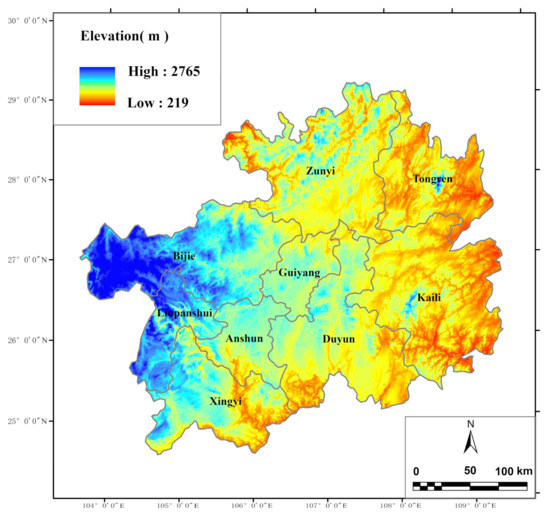
Figure 2.
Counties and the topography of Guizhou Province.
In Guizhou province, Cyclobalanopsis glauca forests are mainly distributed in Fanjing mountain, Weining county, Hezhang county, Pan county, and Anlong county with an altitude ranging from 1300 to 2500 m [8]. According to the field survey, a majority of Cyclobalanopsis glauca forests have been well protected by nature reserves. Nevertheless, a small percentage of them lack adequate management, have been isolated as mosaic patches or degenerated into secondary forests due to frequent human disturbances. More attention should be paid to the protection and restoration of Cyclobalanopsis glauca forests in these regions.
2.2. Distribution Points
The field investigation was launched after consulting previous records, specimens, and literature to acquire longitude, latitude, elevation, and terrain data for sampling points of Cyclobalanopsis glauca forests using a handheld GPS. Sampling points separated by a distance greater than 1 km were imported to ArcGIS [20] and saved as CSV files for modelling. Finally, 79 effective records of the presence of Cyclobalanopsis glauca forests in Guizhou Province were obtained to build the prediction model.
2.3. Climate Data
A set of 19 bioclimatic factors of current and future climate scenarios (Table 1), provided by IPCC5, were downloaded from the WorldClim database (www.worldclim.org, 9 April 2021).

Table 1.
Introduction of 19 bioclimate factors.
Aiming to assess the future climate, IPCC5 developed 4 greenhouse gas concentration scenarios, which were ranked as RCP2.6, RCP4.5, RCP6.0 and RCP8.5 according to the representative concentration pathway scenarios. The RCP8.5 scenario (2070–2099), the most extreme scenario, was selected as the future climate scenario in this study. All climate data were extracted from the administrative boundary of Guizhou Province and saved in ASC format. The WGS84 projection coordinate system was used to match spatial coordinates of climate and geographical data.
2.4. Modelling and Validation
Owing to its superior performance, excellent accuracy, and convenient operation, the maximum entropy model (MaxEnt) was applied to predict the potential distribution of Cyclobalanopsis glauca forests in Guizhou Province. In total, 80% of the current distribution samples were randomly selected to construct the model, and the remaining 20% were used for accuracy testing [21]. A map of the probability distribution, ranging from 0 to 1 for each grid cell, was generated after the input of sampling points and climate layers, setting of the parameters, and operation of the model [22].
The model was evaluated by cross validation with MaxEnt, and performance was assessed by calculating the area under the curve (AUC) of the receiver operating characteristic (ROC) plot. Values of the AUC ranged from 0.5 to 1, with values above 0.9 indicating excellent performance of the model [23,24].
2.5. Suitability and Sensitivity Assessment
Based on data imported in ArcGIS, the probability distribution map of ASC was converted into IMG or TIF format, and the reclassification operation was performed to reveal the optimal degree of the potential distribution of Cyclobalanopsis glauca forests in Guizhou Province.
The Intergovernmental Panel on Climate Change (IPCC) defined sensitivity as the degree to which a system is affected, either adversely or beneficially, by climate-related stimuli [25]. In this study, sensitivity was interpreted as the magnitude of change in habitat suitability with regards to climate change. A sensitivity index (SI) was defined as the difference between potential probability of occurrence under the current climate and that under future climate scenarios for each grid: SI = Pro.S − Pro.C [26]. The values of SI ranged from −1 to 1, where positive and negative values indicated a rise and a decline, respectively, in the potential probability of Cyclobalanopsis glauca forests. A sensitivity map with attribute tables was exported to reveal the suitability and sensitivity characteristics of Cyclobalanopsis glauca forests in the current and future climate scenarios.
Finally, a spatial join was executed using the sensitivity index layer and digital elevation model (DEM) data of 30 m resolution (downloaded from the Geospatial Data Cloud: http://www.gscloud.cn, 6 February 2021), and a boxplot based on the results was drawn to clarify altitude characteristics of the sensitivity areas in different probability intervals.
3. Results
3.1. Prediction Accuracy
The ROC analysis results of the accuracy test are shown in Figure 3. AUC values of training data and testing data were 0.974 and 0.921, respectively, indicating excellent performance of the model.
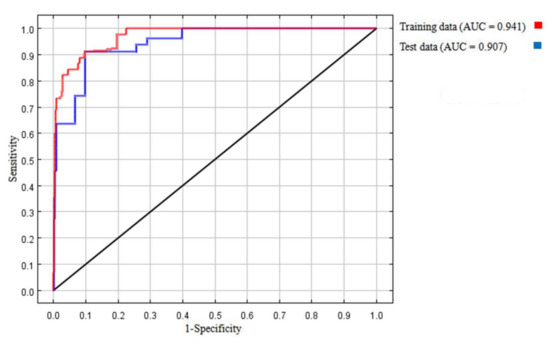
Figure 3.
Receiver operating characteristic (ROC) curve.
3.2. Potential Probability under Current Climate and RCP8.5 Scenarios
Distribution maps and their attribute data of potential probability under current climate and RCP8.5 scenarios (Figure 4 and Figure 5; Table 2) were exported on the basis of prediction results of the model. Most regions exhibited a low probability (probability < 0.4), and high probability regions (probability > 0.6) were concentrated in Tongren, Kaili, Zunyi, and Duyun under both the current and future climate conditions. Compared to current climate conditions, areas of probability < 0.4 decreased and others displayed an increasing trend under the RCP8.5 scenario.
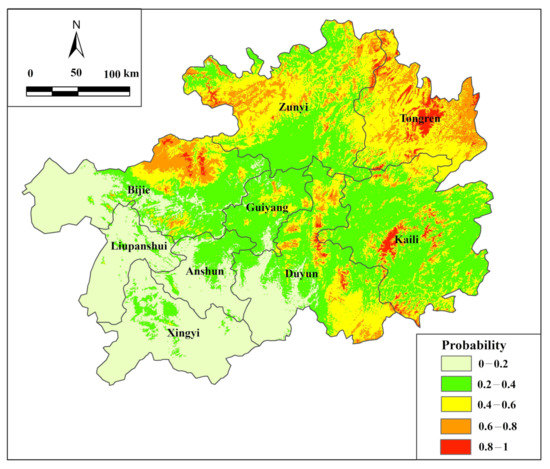
Figure 4.
Potential probability under current climate.
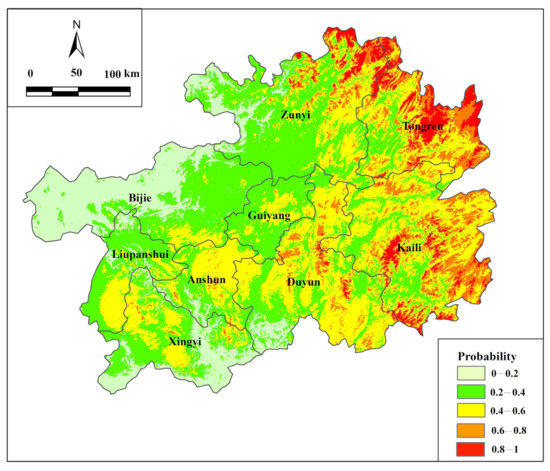
Figure 5.
Potential probability under RCP8.5 scenario.

Table 2.
Probability statistics under current climate and RCP8.5 scenarios.
3.3. Sensitivity Assessment
Highly positive sensitivity areas (SI > 0.5) were mostly distributed in north-eastern Guizhou, and highly negative areas (SI < −0.5) were mostly distributed in north-western Guizhou. Positive sensitivity areas (132, 425.25 km2) were much larger than negative sensitivity areas (43, 741.75 km2) under climate change conditions. Slight sensitivity areas (−0.25 < SI < 0.25) accounted for the largest proportion, in which slightly negative sensitivity areas (−0.25 < SI < 0) and slightly positive sensitivity areas (0 < SI < 0.25) covered 36, 043.25 km2 and 115, 830.32 km2, respectively (Figure 6; Table 3).
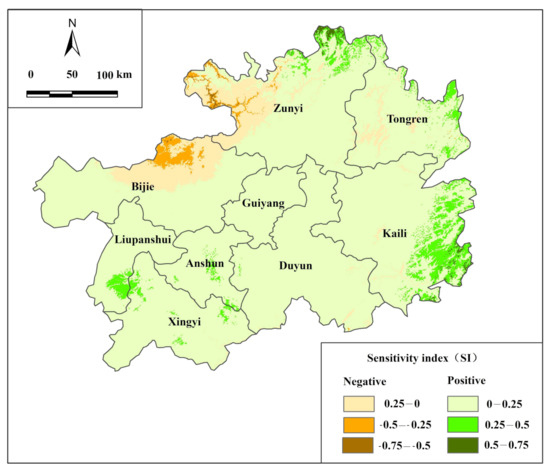
Figure 6.
Map of sensitivity index (SI) under climate change.

Table 3.
Statistics of sensitivity index (SI) under climate change.
The mean altitude of slight sensitivity areas (−0.25 < SI < 0.25) was the lowest, with slightly negative sensitivity areas (−0.25 < SI < 0) and slightly positive sensitivity areas (0 < SI < 0.25) being at 869 m.a.s.l. and 899 m.a.s.l., respectively. The mean altitude of highly negative sensitivity areas (−0.75 < SI < −0.5) measured the highest (1136 m.a.s.l.). The statistical values of highly positive sensitivity areas (0.5 < SI < 0.75) showed no conspicuous characteristics in terms of mean altitude (Figure 7; Table 4).
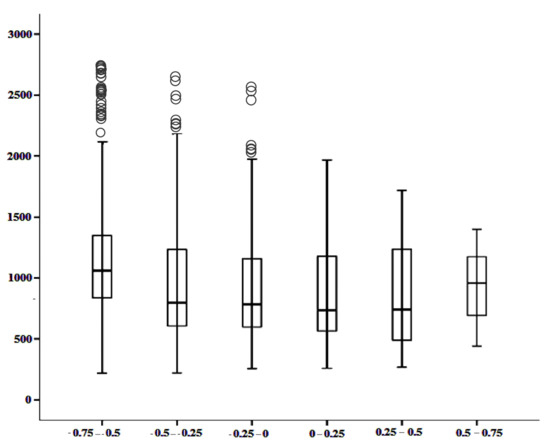
Figure 7.
Boxplot of altitude in different sensitivity index (SI) intervals.

Table 4.
Statistics of altitude in different sensitivity index (SI) intervals.
4. Discussion and Conclusions
4.1. Affecting Factors
The potential distribution of vegetation is affected not only by climate factors but also by non-climate factors such as soil and topography, while climatic factors generally play a decisive role at the macro-scale [26,27]. Since the main purpose of this study is to explore the impact of climate change on potential distribution of Cyclobalanopsis glauca forests at a large scale, climatic factors are taken into consideration solely for the predictive model.
4.2. Changes of Potential Probability
Areas of probability < 0.4 decreased and the other areas increased under the RCP8.5 scenario compared to current climate conditions, indicating a significant expansion of potential habitats of Cyclobalanopsis glauca forests under climate change. Highly positive sensitivity areas (SI > 0.5) were mostly distributed in north-eastern Guizhou, and highly negative areas (SI < −0.5) were mostly distributed in north-western Guizhou, suggesting shifts towards the northeast and degradations in the northwest of Cyclobalanopsis glauca forests might occur in response to climate change. The conclusions were consistent with previous studies conducted in other regions of evergreen broad-leaved forests. Yagihashi et al. suggested that Fagus crenata forests would expand their present range towards the north east under climate change in Japan [28]. Nakao et al. predicted that potential habitats of Quercus acuta forests would migrate northward and upward influenced by climate change [29].
4.3. Sensitivity Characteristics
The mean altitude of slight sensitivity areas (−0.25 < SI < 0.25) was lower compared to that in all other areas, which might be attributed to the relatively stable climatic conditions in these areas. Most of the highly negative sensitivity areas (−0.75 < SI < −0.5) were distributed in the Wumeng mountainous region and occupied the highest mean altitude. Complex terrain with tall mountains and steep valleys increased the protection difficulty in these areas. Great attention and efficient protective measures should be implemented in highly negative sensitivity areas of Cyclobalanopsis glauca forests in Guizhou Province.
4.4. Further Research
(1) This study clarified the impact of climate change on the potential distribution of Cyclobalanopsis glauca forest, meanwhile, further research is needed to explore the feedback mechanism of the changes in vegetation to climate change.
(2) By establishing a mathematic relationship between environmental variables (e.g., temperature, precipitation, soil type, etc.) and distribution data of vegetation, potential vegetation models could predict spatial distribution of vegetation under a greater spatial scope. However, it was hardly possible to evaluate changes in composition, structure and service function of the ecosystem according to the prediction scale of existing models. These factors should be considered in the subsequent development and modification of potential vegetation models.
Author Contributions
Investigation, W.L. and T.F.; Formal analysis, J.H.; Original draft, W.L.; Review and editing, Q.L. All authors have read and agreed to the published version of the manuscript.
Funding
This research was funded by the National Natural Science Foundation of China (31870607, 41930645, 31971637), Key Laboratory of Ecological Protection and Remediation of Typical Plateau Wetland in Guizhou Province [[2020]2002], Bijie Talent Team of Biological Protection and Ecological Restoration in Liuchong River Basin, Project for Youth Science and Technology Talent of Guizhou Provincial Education Department [KY[2018]394], [KY[2020]149].
Institutional Review Board Statement
Not applicable.
Informed Consent Statement
Not applicable.
Data Availability Statement
The data for each of the analyses in this paper are available upon request from the corresponding author.
Conflicts of Interest
The authors declare no conflict of interest.
References
- Nakao, K.; Higa, M.; Tsuyama, I.; Matsui, T.; Horikawa, M.; Tanaka, N. Spatial conservation planning under climate change: Using species distribution modeling to assess priority for adaptive management of Fagus crenata in Japan. J. Nat. Conserv. 2013, 21, 406–413. [Google Scholar] [CrossRef]
- Tang, C.Q.; Dong, Y.-F.; Herrando-Moraira, S.; Matsui, T.; Ohashi, H.; He, L.-Y.; Nakao, K.; Tanaka, N.; Tomita, M.; Li, X.-S.; et al. Potential effects of climate change on geographic distribution of the Tertiary relict tree species Davidia involucrata in China. Sci. Rep. 2017, 7, 43822. [Google Scholar] [CrossRef] [PubMed] [Green Version]
- Zhang, K.; Yao, L.; Meng, J.; Tao, J. Maxent modeling for predicting the potential geographical distribution of two peony species under climate change. Sci. Total Environ. 2018, 634, 1326–1334. [Google Scholar] [CrossRef] [PubMed]
- Sony, R.K.; Sen, S.; Kumar, S.; Monalisa, S.; Jayahari, K.M. Niche models inform the effects of climate change on the endangered Nilgiri Tahr (Nilgiritragus hylocrius) populations in the southern Western Ghats, India. Ecol. Eng. 2018, 120, 355–363. [Google Scholar] [CrossRef]
- Zhuang, H.F.; Qin, H.; Wang, W.; Zhang, Y. Prediction of the potential suitable distribution of Taxus yunnanensis based on Maxent Model. J. Shanxi. Univ. 2018, 41, 233–240. [Google Scholar] [CrossRef]
- Hu, Z.J.; Zhang, Y.L.; Yu, H.B. Simulation of Stipa purpurea distribution pattern on Tibetan Plateau based on Maxent model and GIS. J. Appl. Ecol. 2015, 26, 505–511. [Google Scholar] [CrossRef]
- Wang, G.; Lin, H.L.; He, L.; Cao, A.C. Study on the response of potential distribution of Ageratina adenophora to climate change. Acta. Pratacult. Sin. 2014, 23, 20–30. [Google Scholar]
- Huang, W.L. Vgetation of Guizhou; Guizhou People’s Press: Guiyang, China, 1988; pp. 168–169. [Google Scholar]
- Sun, J.Y. Seedling and afforestation techniques of Cyclobalanopsis glauca. Anhui For. Sci. Technol. 2005, 30, 27. [Google Scholar]
- Xu, J.; Deng, M.; Jiang, X.L.; Westwood, M.; Song, Y.G.; Turkington, R. Phylogeography of Cyclobalanopsis glauca (Fagaceae), a dominant tree of East Asian subtropical evergreen forests, based on three chloroplast DNA interspace sequences. Tree. Genet. Genomes 2015, 11, 805. [Google Scholar] [CrossRef]
- Huang, Q.L.; Zheng, Q.R.; Yuan, X.R. Stand structure and productive forces of Cyclobalanopsis glauca germinating forest in Fujian. J. For. Environ. 1995, 15, 107–111. [Google Scholar] [CrossRef]
- Zhao, L.J.; Xiang, W.H.; Li, J.X.; Deng, X.; Cong, L. Floristic composition, structure and phytogeographic characteristics in a Lithocarpus glaber Cyclobalanopsis glauca forest community in the subtropical region. Sci. Silvae Sin. 2013, 49, 10–17. [Google Scholar] [CrossRef]
- Itô, H.; Sumida, A. Allometric and growth data of an evergreen oak, Quercus glauca, in a secondary broadleaved forest. Ecol. Res. 2017, 32, 105. [Google Scholar] [CrossRef] [Green Version]
- Long, S.S.; Zeng, S.Q.; Xiao, H.S.; Liu, F.; Hu, M. Analysis on the status of Cyclobalanopsis glauca secondary forest based on the improved Hegyi model. For. Res. Manag. 2018, 39, 50–56. [Google Scholar] [CrossRef]
- Peng, S.Y.; Li, T.H.; Wen, S.Z.; He, G.X.; Huang, S.J. Effect of different sand storage methods on the germination of Cyclobalanopsis glauca seed. J. Cent. S Univ. For. Technol. 2016, 36, 44–48. [Google Scholar] [CrossRef]
- Sun, L.; Ataka, M.; Kominami, Y.; Yoshimura, K. Relationship between fine-root exudation and respiration of two Quercus species in a Japanese temperate forest. Tree Physiol. 2017, 37, 1011–1020. [Google Scholar] [CrossRef]
- Ni, J.; Song, Y.C. Relationships between geographic distribution of Cyclobalanopsis glauca and climate in China. Acta. Bot. Sin. 1997, 39, 451–460. [Google Scholar]
- Cao, M.C.; Zhou, G.S.; Weng, E.S. Application and comparison of generalized models and classification and regression tree in simulating tree species distribution. Acta Ecol. Sin. 2005, 25, 2031–2040. [Google Scholar] [CrossRef]
- Yang, R.H. Current situation and utilization of wild woody vine resources in Guizhou. Seed 2008, 27, 55–57. [Google Scholar] [CrossRef]
- Scrivanti, L.R.; Anton, A.M. Impact of climate change on the Andean distribution of Poa scaberula (Poaceae). Flora 2021, 278, 151805. [Google Scholar] [CrossRef]
- Merow, C.; Smith, M.J.; Silander, J.A., Jr. A practical guide to MaxEnt for modeling species’ distributions: What it does, and why inputs and settings matter. Ecography 2013, 36, 1058–1069. [Google Scholar] [CrossRef]
- Phillips, S.J.; Anderson, R.P.; Schapire, R.E. Maximum entropy modeling of species geographic distributions. Ecol. Model. 2006, 190, 231–259. [Google Scholar] [CrossRef] [Green Version]
- Swets, J.A. Measuring the accuracy of diagnostic systems. Science 1988, 240, 1285–1293. [Google Scholar] [CrossRef] [PubMed] [Green Version]
- Ray, D.; Behera, M.; Jacob, J. Predicting the distribution of rubber trees (Hevea brasiliensis) through ecological niche modelling with climate, soil, topography and socioeconomic factors. Ecol. Res. 2016, 31, 75–91. [Google Scholar] [CrossRef]
- Spittlehouse, D. Climate Change. Impacts, Adaptation, and Vulnerability. J. Environ. Qual. 2001, 56, 81–111. [Google Scholar] [CrossRef]
- Matsui, T.; Yagihashi, T.; Nakaya, T.; Taoda, H.; Yoshinaga, S.; Daimaru, H.; Tanaka, N. Probability distributions, vulnerability and sensitivity in Fagus crenata forests following predicted climate changes in Japan. J. Veg. Sci. 2004, 15, 605–614. [Google Scholar] [CrossRef]
- Pearson, R.G.; Dawson, T.; Liu, C. Modelling species distributions in Britain: A hierarchical integration of climate and land-cover data. Ecography 2004, 27, 285–298. [Google Scholar] [CrossRef]
- Yagihashi, T.; Matsui, T.; Nakaya, T.; Tanaka, N.; Taoda, H. Climatic determinants of the northern range limit of Fagus crenata forests in Japan. Plant Species Biol. 2007, 22, 217–225. [Google Scholar] [CrossRef]
- Nakao, K.; Matsui, T.; Horikawa, M.; Tsuyama, I.; Tanaka, N. Assessing the impact of land use and climate change on the evergreen broad-leaved species of Quercus acuta in Japan. Plant Ecol. 2011, 212, 229–243. [Google Scholar] [CrossRef]
Publisher’s Note: MDPI stays neutral with regard to jurisdictional claims in published maps and institutional affiliations. |
© 2022 by the authors. Licensee MDPI, Basel, Switzerland. This article is an open access article distributed under the terms and conditions of the Creative Commons Attribution (CC BY) license (https://creativecommons.org/licenses/by/4.0/).